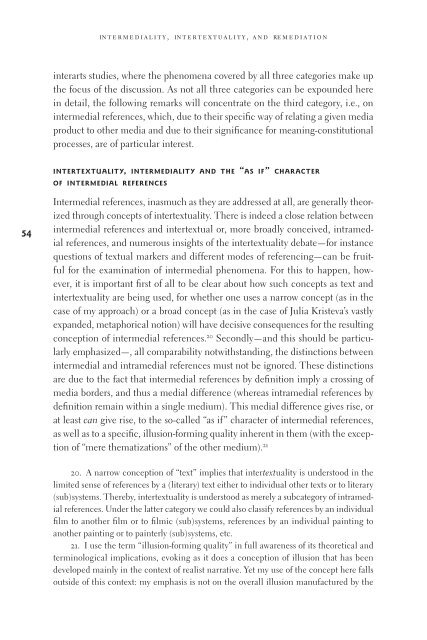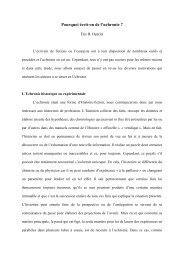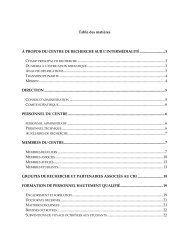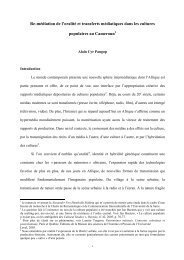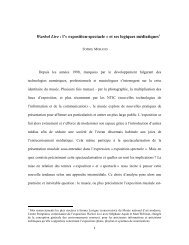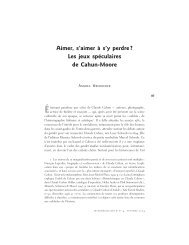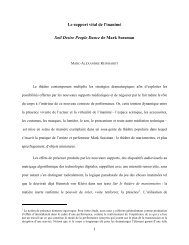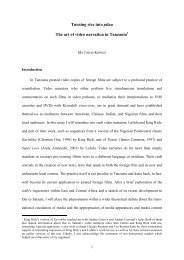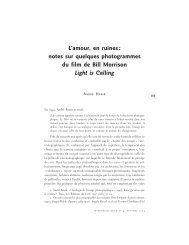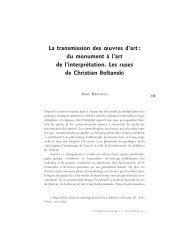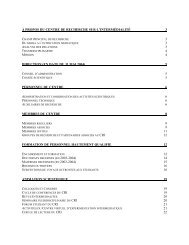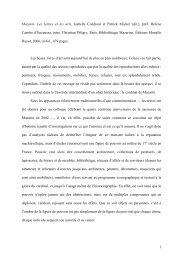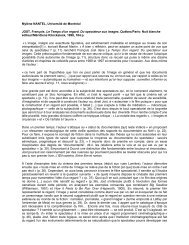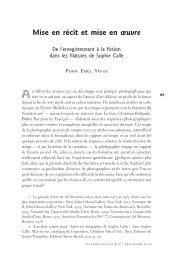Intermediality - Centre de recherche sur l'intermédialité (CRI ...
Intermediality - Centre de recherche sur l'intermédialité (CRI ...
Intermediality - Centre de recherche sur l'intermédialité (CRI ...
You also want an ePaper? Increase the reach of your titles
YUMPU automatically turns print PDFs into web optimized ePapers that Google loves.
54<br />
intermediality, intertextuality, and remediation<br />
interarts studies, where the phenomena covered by all three categories make up<br />
the focus of the discussion. As not all three categories can be expoun<strong>de</strong>d here<br />
in <strong>de</strong>tail, the following remarks will concentrate on the third category, i.e., on<br />
intermedial references, which, due to their specifi c way of relating a given media<br />
product to other media and due to their signifi cance for meaning-constitutional<br />
processes, are of particular interest.<br />
INTERTEXTUALITY, INTERMEDIALITY AND THE “AS IF” CHARACTER<br />
OF INTERMEDIAL REFERENCES<br />
Intermedial references, inasmuch as they are addressed at all, are generally theorized<br />
through concepts of intertextuality. There is in<strong>de</strong>ed a close relation between<br />
intermedial references and intertextual or, more broadly conceived, intramedial<br />
references, and numerous insights of the intertextuality <strong>de</strong>bate—for instance<br />
questions of textual markers and different mo<strong>de</strong>s of referencing—can be fruitful<br />
for the examination of intermedial phenomena. For this to happen, however,<br />
it is important fi rst of all to be clear about how such concepts as text and<br />
intertextuality are being used, for whether one uses a narrow concept (as in the<br />
case of my approach) or a broad concept (as in the case of Julia Kristeva’s vastly<br />
expan<strong>de</strong>d, metaphorical notion) will have <strong>de</strong>cisive consequences for the resulting<br />
conception of intermedial references. 20 Secondly—and this should be particularly<br />
emphasized—, all comparability notwithstanding, the distinctions between<br />
intermedial and intramedial references must not be ignored. These distinctions<br />
are due to the fact that intermedial references by <strong>de</strong>fi nition imply a crossing of<br />
media bor<strong>de</strong>rs, and thus a medial difference (whereas intramedial references by<br />
<strong>de</strong>fi nition remain within a single medium). This medial difference gives rise, or<br />
at least can give rise, to the so-called “as if” character of intermedial references,<br />
as well as to a specifi c, illusion-forming quality inherent in them (with the exception<br />
of “mere thematizations” of the other medium). 21<br />
20. A narrow conception of “text” implies that intertextuality is un<strong>de</strong>rstood in the<br />
limited sense of references by a (literary) text either to individual other texts or to literary<br />
(sub)systems. Thereby, intertextuality is un<strong>de</strong>rstood as merely a subcategory of intramedial<br />
references. Un<strong>de</strong>r the latter category we could also classify references by an individual<br />
fi lm to another fi lm or to fi lmic (sub)systems, references by an individual painting to<br />
another painting or to painterly (sub)systems, etc.<br />
21. I use the term “illusion-forming quality” in full awareness of its theoretical and<br />
terminological implications, evoking as it does a conception of illusion that has been<br />
<strong>de</strong>veloped mainly in the context of realist narrative. Yet my use of the concept here falls<br />
outsi<strong>de</strong> of this context: my emphasis is not on the overall illusion manufactured by the


